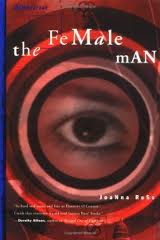 A Kaleidoscope of Early Feminism
A Kaleidoscope of Early Feminism
Russ, Joanna. (1975). The Female Man. Boston: Beacon.
Four women live in different worlds, and each world has a different definition of what it means to be a woman. Through some fantasy magic, they are able to visit each other’s worlds to see how women live and are treated there. This is the author’s technique for encouraging the reader to question the status quo on Earth (in 1975). The theme of the novel is ardently feminist, often angry, sometimes plaintive.
Joanna lives on Earth in the 1970’s, just when the women’s movement was erupting into mass media and popular awareness. In her world, men still attempt to exploit women, especially sexually, while women are becoming aware of the gender-based social games that presuppose women’s inferiority and vulnerability. Some of these games are revealed to us when Joanna invites Janet to a party.
Janet is from the distant future where there are no men. All the men died of a plague 800 years ago. Women reproduce by genetic engineering and live in a cooperative, technologically advanced, but bucolic society. Janet has no concept that women are inferior and does not understand the meaning of gender-based social games. At the party, Joanna says her friend Janet is “from Sweden” to explain her strange conversation. When a man tries to crudely seduce Janet, she decks him. Joanna hustles Janet out of the room. It’s one of the best chapters in the book. Janet is a bit of an anthropologist, fascinated by the 20th-century Earthlings. At her request, Joanna arranges for her to live a while with an Earth family, where she makes a big impression on the teenage daughter, leading to a sexual relationship that is taboo for both cultures.
In another episode of time-traveling, Janet pops into the world of Jeanine, a woman who lives in a place just like Earth during the Great Depression, except that the Depression never ended and the relative poverty and conservative values of that era persisted for generations. Jeanine isn’t the least bit “liberated” and all she wants is to find a man and get married. Trouble is, all the men she knows treat her badly. She has a sexual relationship with her boyfriend, Cal, but it is not satisfying. She hopes for Prince Charming. Janet is “discovered” by the media in Jeanine’s world, put on television and studied by scientists, who want to know what her world is like. They are incredulous that a society could get along without men. But there isn’t much on how Janet’s arrival specifically stirs up Jeanine’s gender role definition.
Through sci-fi magic again, Jeanine and Joanna get together and go with Janet to her home in the future world of Whileaway, where they meet Janet’s wife, but nothing very interesting happens there. Then Joanna visits Jeanine’s world with Jeanine, whose mother nags her about not being married yet. Jeanine explains that she can’t find the right man. There is little description of Joanna’s reaction to this, and no explicit dialog between the women about it.
In another episode, Janet, Jeanine, and Joanna are summoned (somehow) into the world of Jael, a world whose defining feature is that the “battle of the sexes” has been literal warfare for forty years. The women live completely apart from the men, and trade children to them in exchange for minerals and other goods. On the male side, young men are partially transgendered to satisfy older men’s sexual needs. Jael is a negotiator for the women, but also a professional assassin and in one of most coherent scenes in the book, we see her kill a man with her bare hands when he tries to sexually seduce her. Again, there is no discussion among the other three J’s about their reaction, a lost opportunity, it would seem.
Throughout the book I was frustrated by scenes, such as those described, presented without comment or evaluation, either by the narrator or by any of the the four women themselves. As a result, none of the women reacts to events in ways that reveal character, so they all remain two-dimensional placeholders. That made the book really only a collection of scenes, without a continuous narrative thread, without the characters becoming developed, and without the overarching feminist theme being articulated. I found it not only frustrating, but a tremendous lost opportunity.
On the other hand, one could argue that the whole point was the scenes themselves. They are self-explanatory, if heavy-handed: sexism is bad, gender-role freedom is good. But that’s not as engaging as discovering interesting characters. Characters usually are not interesting in the sci-fi genre, which is all about the intellectual idea, so maybe I just don’t appreciate the genre.
Also, there is the possibility that there was plenty of commentary and interpretation of the scenes by the narrator, but I just didn’t “get it.” Many of the so-called chapters struck me as utter nonsequiturs, possibly snippets dropped in from another text. The totally chaotic narration makes the book extremely difficult to read, to the point of it being literally nonsensical for the first 130 pages. Or was that just me? This anti-novel has won many, many awards for fiction, so I should only say it was not my cup of tea.
Still, the book is consistently interesting, even when it does not apparently contribute to any story or character, such as Chapter VIII, apropos of nothing, in its entirety:
Men succeed. Women get married.
Men fail. Women get married.
Men enter monasteries. Women get married.
Men start wars. Women get married.
Men stop them. Women get married.
Dull, dull. (see below)
